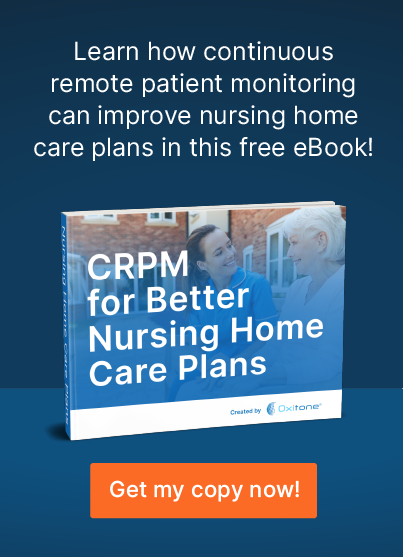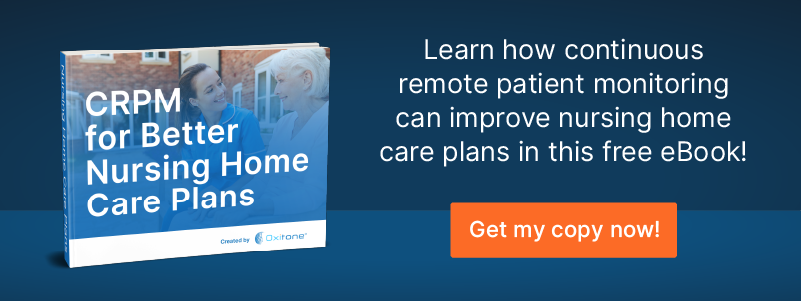When it comes to healthcare costs, more than half of all spending is on care for adults fifty-five or older. The highest share of spending is for those aged sixty-five and over. These older adults also have the highest volume of chronic comorbid conditions. This can become challenging for nursing homes and assisted living facilities as they try to balance appropriate care with cost containment. That’s why so many facilities have turned to remote patient monitoring home health solutions.
Remote Patient Monitoring Home Health: The Benefits of CRPM for Nursing Homes
Continuous remote patient monitoring (CRPM) in nursing homes can help monitor chronic conditions. Many patients with chronic illnesses don’t take their medication properly to manage their conditions. In fact, half of those with chronic illnesses stop taking medication within one year. Even with supervision, residents can fail or forget to manage their medication levels.
According to the American Medical Association, medication issues lead to as much as $300 billion in what it calls “avoidable health care costs.” Often, medication issues aren’t uncovered until after patients suffer from adverse reactions.
Remote patient monitoring home health solutions, such as CRPM, can aid in the monitoring of adverse conditions by detecting even small changes in patient vital signs before they reach critical levels.
Reduces Hospital Readmission Rates
By automatically monitoring for changes, nursing home facilities can significantly cut down on hospital readmission rates.
For example, 25% of patients discharged to a skilled nursing facility are readmitted within thirty-nine days. The biggest cause of avoidable readmissions is infection. The continuous monitoring of temperature using remote patient monitoring home health solutions can provide earlier detection of patient temperature changes and other warning signs of infections.
Helps Monitor Patients with Alzheimer’s, Dementia, or Memory Loss
Nursing home residents with Alzheimer’s, dementia, or memory loss can have difficulty self-regulating. They may forget to take medication or accidentally take multiple doses. They may not notice even a significant change in their condition.
CRPM can monitor, track, and detect changes in conditions that may be indicative of potential problems. AI-enhanced wearable devices, such as the Oxitone 1000M, provide continuous monitoring and use predictive analysis by comparing current conditions with multi-parameter baselines. This allows the identification of risk in real time.
Creates Collaborative Healthcare
Remote patient monitoring home health solutions enable better collaboration among nursing home residents, caregivers, and physicians.
Residents can monitor their own conditions in real time, which allows them to learn what triggers adverse events and avoid them in the future. CRPM also enables caregivers and physicians to monitor for changes to provide an earlier warning of health concerns.
Remote patient monitoring home health solutions are effective when physicians want to monitor follow-up care more easily, without the need to schedule appointments. This reduces the need to transport residents to doctors’ offices as often.
Lightens the Workload for Caregivers
CRPM provides detailed information on health without manual intervention. Caregivers do not need to worry about checking vital signs or juggling multiple devices to monitor different parameters. CRPM provides faster access to health information while freeing caregivers from routine—but important—tasks.
Since it provides information to caregivers and nursing home residents, CRPM also has a greater influence on patient ownership of the data.
Improves Compliance Rates
Deploying remote patient monitoring home health solutions leads to higher compliance rates for patients.
When patients are aware of their health conditions and have an easy way to detect changes, they are more likely to follow the prescribed medical regimen. This leads to better outcomes overall and reduced exacerbations.
Provides Health Benefits to Caregivers
Nursing home staff members have the potential to be exposed to infectious diseases and sick patients on a routine basis. This was particularly evident during the COVID-19 pandemic.
The US Department of Health and Human Services (HHS) recognized this additional threat to caregivers and expanded Medicare coverage of remote patient monitoring. The HHS also emphasized how remote patient monitoring home health solutions enabled the monitoring of patient conditions without risking additional exposure: “Nurses, working with physicians, can check-in with the patient and then using patient data, determine whether home treatment is safe, all the while reducing exposure risk and eliminating potentially unnecessary emergency department and hospital visits.”
Here at Oxitone, we boost value-based healthcare by delivering extraordinary patient, clinical, and economical outcomes at reduced medical utilization and cost. Patients need a prompt response to emergencies. Physicians need an easy and timely follow-up with patients. Our mission is to transform chronic disease management and help save lives worldwide.
Let’s save lives together! To see how we help remote patient monitoring companies and physicians improve the management and care of high-risk patients, contact us today!


